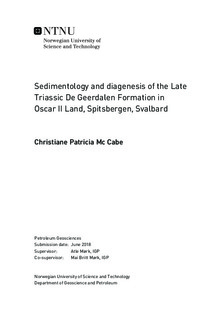Sedimentology and diagenesis of the Late Triassic De Geerdalen Formation in Oscar II Land, Spitsbergen, Svalbard
Abstract
This study presents a sedimentological and petrographical investigation of the Upper Triassic De Geerdalen Formation on Oscar-II Land, western Spitsbergen, Svalbard. The De Geerdalen Formation represents paralic deposition during the Early Carnian to Early Norian in a shallow embayment. The formation has been studied extensively in Svalbard. However, due to the extensive tectonism associated with the West Spitsbergen Fold and Thrust Belt (WSFTB), few previous studies have focus on the succession in Oscar-II Land.Four stratigraphic sections have been measured in the Upper Triassic succession on Oscar-II Land. Combining stratigraphic and petrographic methods, the depositional environment and palaeogeographic setting are explored. The spread of localities across the zones of the WSFTB (from Basin-involved to thin-skinned fold-thrust complexes) provides insights into the effects of increasing compaction on the diagenetic history. Both quartz and carbonate cements are common. The presence of chlorite coatings corresponds to decreased cementation and extensive compaction Units cemented by pervasive calcite cement exhibit minimal compaction, regardless of their position in WSFTB.The lower part of the measured sections exhibit strong wave or storm influences in a paralic environment. Fluvial sedimentary structures are absent, but a brackish influence may be implied by early diagenetic precipitates of grain-coating chlorite, siderite, and zoned dolomites. Wave influences are strongest to the west, while to the east of the Isfjorden-Ymerbukta Fault Zone (IYFZ), tidal influences are inferred. The IYFZ also appears to correlate to the variation in composition, with quartz rich sandstones to the west and an increased presence of carbonates to the east. Both western and eastern sediment sources are implied in the study area. The presence of detrital glauconites in storm beds also suggests sediments have been reworked from the basin. The upper part of the succession corresponds to the Isfjorden Member and represents interdistributary bay or lagoonal deposits. Palaeogeographic setting is discussed, but remains uncertain. Detailed geochemical analyses are needed to better constrain the findings presented herein.
